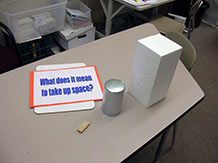What does it mean to take up space?
1. Ask the question
Ask children to bring some of their creations from the 10–10–10–10 Challenge to the circle (if available). Recall the materials they were given to work with: 10 grams of Styrofoam, 10 grams of aluminum foil, 10 grams of wooden stirrers, and 10 grams of plastic modeling clay.
- All four materials weighed exactly the same — 10 grams. What differences did you notice about how much of each material you were given?
If students reply that there is “more of” some materials than others, or that the portions were “bigger,” challenge them:
- But they weigh the same. What do you mean? What is different?
Let them struggle to describe the difference until they arrive at a consensus that some materials “take up more space,” or have a “bigger shape,” or “hold more air.” Then pose the new investigation question:
Talking points: This investigation introduces the concept of volume, but use the more descriptive phrase “takes up space” until the very end of the session. This phrase is more readily understood by children and it underscores the three–dimensional nature of the concept.

As the children talk about space, size and shape, make sure they are not thinking only of height and length. Listen for language that indicates they are thinking three–dimensionally, words like back, front, top, bottom, back and forth, sideways, inside, outside, all over, all around, altogether, everywhere, the whole size, the whole shape, holding air, “like a box.”
- How many sides does space have? How could we ever measure it?
As the discussion winds down, tell students that, just as objects have height and weight, every object also takes up space. Put the tall pillar candle on the floor and use your hands to define the amount of space the candle takes up, moving two hands around and above the candle, to illustrate how much space this candle takes up.
Modeling 3–dimensional objects: To demonstrate the meaning of how much space an object takes up, use both hands, in motion, to show all of the physical boundaries of an object — its top and bottom, its left and right boundaries, its front and back boundaries. By keeping your hands in motion, you focus attention on the size of the whole object — not only its height or length — and embody the three–dimensionality of the concept.
Next place the maple block beside the candle and move your fingers around the block in a similar way, to illustrate how much space the wood block takes up.
Finally, invite some comparisons:
- Which object takes up more space, the candle or the block of wood?
- What about this block of Styrofoam? How does it compare?
Leave the Styrofoam block, pillar candle, and maple block in order for later reference.



